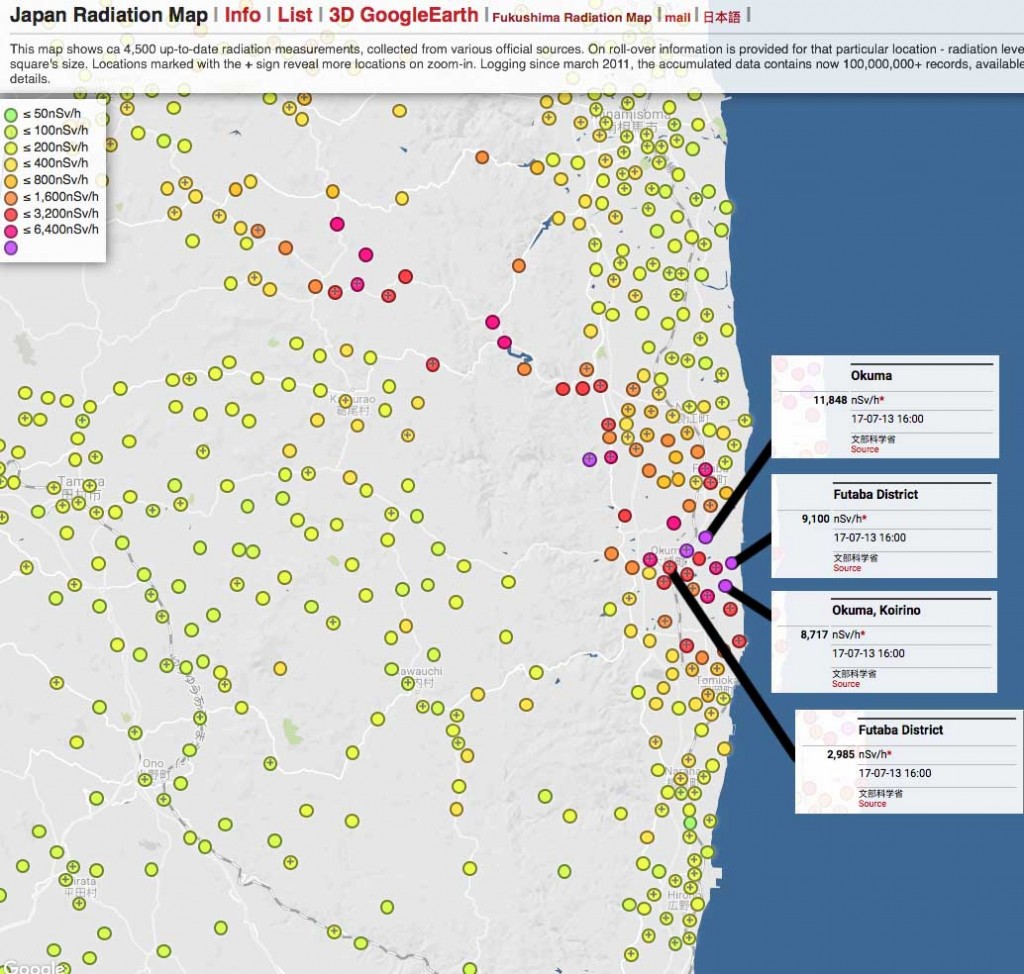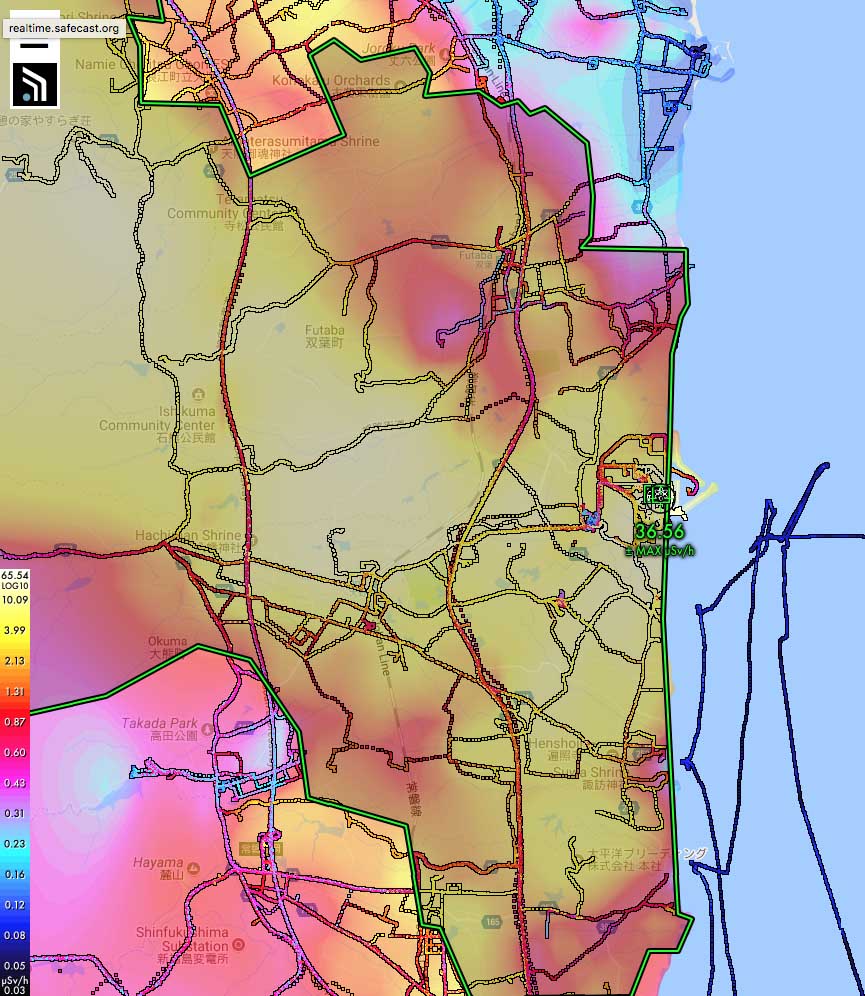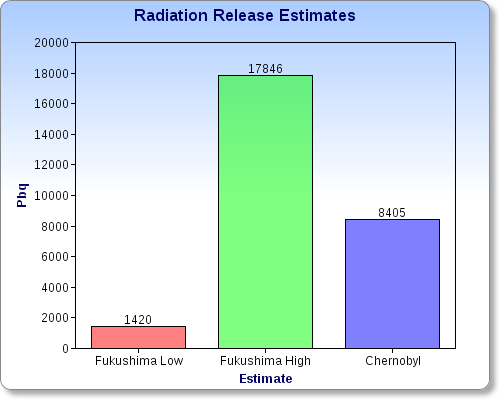GOOGLE EARTH – Japan Levels – Constantly Updated
http://jciv.iidj.net/map/fukushima/
http://jciv.iidj.net/map/fukushima/list
Radiation levels exceeding state-set limit found on grounds of five Chiba schools — The Japan Times
” Radiation levels exceeding the government-set safety limit of 0.23 microsieverts per hour have been detected on the grounds of five schools in the city of Kashiwa, Chiba Prefecture, the prefectural board of education said Monday.
Between late April and mid-May, the board officials detected radiation levels of up to 0.72 microsieverts per hour in certain areas of the schools, including Kashiwa High School and Kashiwa Chuo High School. The areas — including soil near a school swimming pool and drainage gutters — are not frequented by students, but the board closed them off and will work to quickly decontaminate them, the officials said.
Kashiwa has been one of the areas with high radiation readings since the 2011 nuclear disaster at Tokyo Electric Power Company Holdings Inc.’s Fukushima No. 1 power plant.
According to NHK, the board of education had been checking the soil on the school premises in Kashiwa after radiation levels beyond the state limit were detected in shrubbery near the city’s public gymnasium. The board will announce the results of radiation tests at other schools in the prefecture around the end of July, NHK reported. ”
by Kyodo, The Japan Times
MEASUREMENTS : Units of Ionizing Radiation
This is an ongoing collection of conversion factors used to change a radiation reading into another type of measurement.
Picocuries per liter (pCi/L) multiply the amount by 0.037 to get becquerels per liter (Bq/L)
What is a Sievert? http://en.wikipedia.org/wiki/Sievert
What is a Gray? http://en.wikipedia.org/wiki/Gray_(unit)
What is a Rad? http://en.wikipedia.org/wiki/Rad_(unit)
What is a Curie? http://en.wikipedia.org/wiki/Curie_(unit)
What is a Becquerel? http://en.wikipedia.org/wiki/Becquerel_(unit)
What is a Roentgen? http://en.wikipedia.org/wiki/Roentgen_(unit)
http://www.fukuleaks.org/web/?page_id=5675
What Is CPM in Radiation? – SOEKS
Posted by soeks-usa.com on
What Are Counts Per Minute in Radioactivity?
When you get a Geiger counter and are learning how to use it, you’ll need to know about CPM, which is the counts per minute that you’ll see displayed on the analog meter in addition to the corresponding level of radiation. You might sometimes see counts per second, or CPS, instead, or you can easily convert from CPM to CPS if you’d like by dividing your CPM value by 60. So what is the CPM reading all about?
How Does CPM Work?
The counts per minute measurements are generally used to pick up the amount of particles around, which could include alpha or beta particles. A different level of measurement tends to be used for rays, including gamma rays and X-rays.
Instead of showing how much radiation something is giving off, the CPM radiation levels tell how many detection events the meter picks up. So the CPM amount doesn’t show you the amount or strength of the radiation. The device that you’re using to measure radiation can then also tell you the dose rate, although the conversion from CPM to dose rate will vary based on your specific device and some other factors, such as the kind of radiation. A Geiger meter uses energy compensation to create a reading of the dose.
While the measuring rate is “counts per minute,” the device often takes a sample from less time than the full minute and then determines what the total would be for the minute based on that sample.
What Does the CPM Value Mean?
Once you get your CPM reading from your device, you then need to figure out what that reading means. What are normal radiation levels CPM and what are dangerous ones? If you have your Geiger counter calibrated to Cs137, which most are, 1 milliRad per hour would equate to 1,200 CPM on your counter. At the same time, 1 microSievert per hour would equate to 120 CPM on the reading. These are more universal units of measurement that can help you better understand your radiation exposure.
A CPM reading of at least 100 is considered a warning level by the Radiation Network, although the length of time you’re exposed to the radiation is an important factor. If you’re concerned about staying within safe radiation levels, Ken Jorgustin explains on the Modern Survival Blog that it would take 432 days at a CPM of 100 to up your chance of getting cancer to odds of 1 in 1,000. At higher exposure rates, it would take less time. For instance, it would only take four days to increase your rate to those odds if you’re exposed to a level of 10,000 CPM.
When you use a Geiger Mueller detector, you’ll be able to easily see the counts per minute of radiation in a certain area. This can help you understand more about your environment and your exposure.
Units of Measurement (Radiation)
1 rad = 0.01 gray (Gy)
1 gray (Gy) = 100 rad
1 rem = 0.01 sievert (Sv)
1 sievert (Sv) = 100 rem
Rad and Gray are ‘absorbed dose’ units.
Rem and Sievert are ‘equivalent dose’ units.
Why a Rem and a Sievert?
They relate to biological damage done to human tissue and factor the differences between types of radiation. A multiplication factor is used that represents the ‘effective’ biological damage of a given type of radiation. This is the main reason for these units – to factor the differences in damage that is caused from one type of radiation to the next.
Radiation Factor (QF Quality Factor)
(1) Beta
(1) Gamma
(1) X-ray
(10) Nuetron
(20) Alpha
For example, the list above shows that a ‘rad’ or ‘gray’ unit of ‘Alpha’ energy that is absorbed by soft human tissue does 20 times more damage than a ‘rad’ or ‘gray’ of Gamma, X-ray or Beta radiation.
What units are used for measuring radioactivity? – CCOHS Canada
Radioactivity or the strength of radioactive source is measured in units of becquerel (Bq).
1 Bq = 1 event of radiation emission or disintegration per second.
One becquerel is an extremely small amount of radioactivity. Commonly used multiples of the Bq unit are kBq (kilobecquerel), MBq (megabecquerel), and GBq (gigabecquerel).
1 kBq = 1000 Bq, 1 MBq = 1000 kBq, 1 GBq = 1000 MBq.
An old and still popular unit of measuring radioactivity is the curie (Ci).
1 Ci = 37 GBq = 37000 MBq.
One curie is a large amount of radioactivity. Commonly used subunits are mCi (millicurie), µCi (microcurie), nCi (nanocurie), and pCi (picocurie).
1 Ci = 1000 mCi; 1 mCi = 1000 µCi; 1 µCi = 1000 nCi; 1 nCi = 1000 pCi.
Another useful conversion formula is:
1 Bq = 27 pCi.
Becquerel (Bq) or Curie (Ci) is a measure of the rate (not energy) of radiation emission from a source.
How much radiation is too much? – PBS
Converting-cpm-to-microsieverts
Videos from British Columbia :
https://www.youtube.com/watch?v=m61UyoEHF8Q
Videos from Japan :
https://www.youtube.com/watch?v=kfgYRIGjNkA
https://www.facebook.com/NoNukePlanet/videos/1424128864333163/?hc_ref=PAGES_TIMELINE
https://travel.gc.ca/destinations/japan
“Im waking up, to ash and dust, I wipe my brow, and sweat my rust, I’m bringing in the chemicals..” Radioactive (Image Dragons)
Olympic torch for Japan’s 2020 games to start in tsunami-hit Fukushima
Tokyo — Tokyo Olympic organisers said on Thursday that the torch relay for the 2020 Summer Games will begin in Fukushima, a region devastated by the 2011 tsunami and resulting nuclear disaster.
The route for the relay, scheduled to start on March 26 2020, was approved by the Japanese organising committee at a meeting with government officials.
The torch will head south to the sub-tropical island of Okinawa — starting point for the 1964 Tokyo Games relay — before returning north and arriving in the Japanese capital on July 10, according to organisers. “It is very significant to carry the torch of reconstruction across the country, beginning in Fukushima,” said Tokyo governor Yuriko Koike.
Fukushima suffered heavily in the massive March 2011 tsunami, which slammed into a nuclear plant and triggered a meltdown of three reactors. More than 18,000 people died in north-east Japan as a result of the huge earthquake and tsunami, while tens of thousands have been unable to return to their home towns.
“By naming Fukushima as the starting point of the torch relay, it marks these Olympics as the Games of recovery,” Masayoshi Yoshino, Japan’s disaster reconstruction minister, told local media. “We would like to see survivors take part as torch runners to help people in the disaster-hit areas.”
The torch will visit all 47 Japanese prefectures before the lighting of the Olympic cauldron when the 2020 Games open on July 24.
AFP
Fukushima: A Nuclear War without a War
The Unspoken Crisis of Worldwide Nuclear Radiation
Michel Chossudovsky (Editor)
I-Book No. 3, January 25 2012
Global Research’s Online Interactive I-Book Reader brings together, in the form of chapters, a collection of Global Research feature articles and videos, including debate and analysis, on a broad theme or subject matter.
In this Interactive Online I-Book we bring to the attention of our readers an important collection of articles, reports and video material on the Fukushima nuclear catastrophe and its impacts (scroll down for the Table of Contents).
To consult our Online Interactive I-Book Reader Series, click here.
INTRODUCTION
The World is at a critical crossroads. The Fukushima disaster in Japan has brought to the forefront the dangers of Worldwide nuclear radiation.
The crisis in Japan has been described as “a nuclear war without a war”. In the words of renowned novelist Haruki Murakami:
“This time no one dropped a bomb on us … We set the stage, we committed the crime with our own hands, we are destroying our own lands, and we are destroying our own lives.”
Nuclear radiation –which threatens life on planet earth– is not front page news in comparison to the most insignificant issues of public concern, including the local level crime scene or the tabloid gossip reports on Hollywood celebrities.
While the long-term repercussions of the Fukushima Daiichi nuclear disaster are yet to be fully assessed, they are far more serious than those pertaining to the 1986 Chernobyl disaster in the Ukraine, which resulted in almost one million deaths (New Book Concludes – Chernobyl death toll: 985,000, mostly from cancer Global Research, September 10, 2010, See also Matthew Penney and Mark Selden The Severity of the Fukushima Daiichi Nuclear Disaster: Comparing Chernobyl and Fukushima, Global Research, May 25, 2011)
Moreover, while all eyes were riveted on the Fukushima Daiichi plant, news coverage both in Japan and internationally failed to fully acknowledge the impacts of a second catastrophe at TEPCO’s (Tokyo Electric Power Co Inc) Fukushima Daini nuclear power plant.
The shaky political consensus both in Japan, the U.S. and Western Europe is that the crisis at Fukushima has been contained.
The realties, however, are otherwise. Fukushima 3 was leaking unconfirmed amounts of plutonium. According to Dr. Helen Caldicott, “one millionth of a gram of plutonium, if inhaled can cause cancer”.
An opinion poll in May 2011 confirmed that more than 80 per cent of the Japanese population do not believe the government’s information regarding the nuclear crisis. (quoted in Sherwood Ross, Fukushima: Japan’s Second Nuclear Disaster, Global Research, November 10, 2011)
The Impacts in Japan
The Japanese government has been obliged to acknowledge that “the severity rating of its nuclear crisis … matches that of the 1986 Chernobyl disaster”. In a bitter irony, however, this tacit admission by the Japanese authorities has proven to been part of the cover-up of a significantly larger catastrophe, resulting in a process of global nuclear radiation and contamination:
“While Chernobyl was an enormous unprecedented disaster, it only occurred at one reactor and rapidly melted down. Once cooled, it was able to be covered with a concrete sarcophagus that was constructed with 100,000 workers. There are a staggering 4400 tons of nuclear fuel rods at Fukushima, which greatly dwarfs the total size of radiation sources at Chernobyl.” ( Extremely High Radiation Levels in Japan: University Researchers Challenge Official Data, Global Research, April 11, 2011)
Worldwide Contamination
The dumping of highly radioactive water into the Pacific Ocean constitutes a potential trigger to a process of global radioactive contamination. Radioactive elements have not only been detected in the food chain in Japan, radioactive rain water has been recorded in California:
“Hazardous radioactive elements being released in the sea and air around Fukushima accumulate at each step of various food chains (for example, into algae, crustaceans, small fish, bigger fish, then humans; or soil, grass, cow’s meat and milk, then humans). Entering the body, these elements – called internal emitters – migrate to specific organs such as the thyroid, liver, bone, and brain, continuously irradiating small volumes of cells with high doses of alpha, beta and/or gamma radiation, and over many years often induce cancer”. (Helen Caldicott, Fukushima: Nuclear Apologists Play Shoot the Messenger on Radiation, The Age, April 26, 2011)
While the spread of radiation to the West Coast of North America was casually acknowledged, the early press reports (AP and Reuters) “quoting diplomatic sources” stated that only “tiny amounts of radioactive particles have arrived in California but do not pose a threat to human health.”
“According to the news agencies, the unnamed sources have access to data from a network of measuring stations run by the United Nations’ Comprehensive Test Ban Treaty Organization. …
… Greg Jaczko, chair of the U.S. Nuclear Regulatory Commission, told White House reporters on Thursday (March 17) that his experts “don’t see any concern from radiation levels that could be harmful here in the United States or any of the U.S. territories”.







